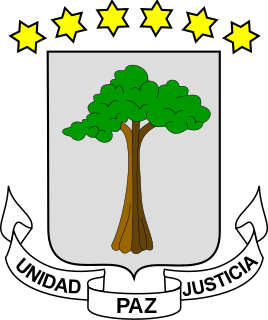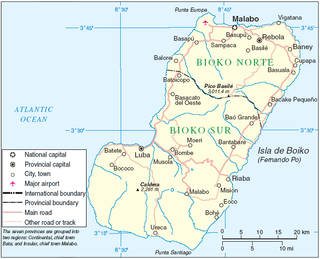Related Research Articles

Equatorial Guinea, officially the Republic of Equatorial Guinea, is a country located on the west coast of Central Africa, with an area of 28,000 square kilometres (11,000 sq mi). Formerly the colony of Spanish Guinea, its post-independence name evokes its location near both the Equator and the Gulf of Guinea. Equatorial Guinea is the only sovereign African state in which Spanish is an official language. As of 2015, the country had a population of 1,225,367.

This article lists transport in Equatorial Guinea.

A transitional agreement, signed in October 1968, implemented a Spanish preindependence decision to assist Equatorial Guinea and provided for the temporary maintenance of Spanish forces there. A dispute with President Francisco Macías Nguema in 1969 led to a request that all Spanish troops immediately depart, and many civilians left at the same time. Diplomatic relations between the two countries were never broken but were suspended by Spain in March 1977 in the wake of renewed disputes. After Macias' fall in 1979, President Teodoro Obiang Nguema Mbasogo asked for Spanish assistance, and since then, Spain has regained influence in Equatorial Guinea's diplomatic relations. The two countries signed permanent agreements for economic and technical cooperation, private concessions, and trade relations. President Obiang made an official visit to Madrid in March 2001, and senior Spanish Foreign Ministry officials visited Malabo during 2001 as well. Spain maintained a bilateral assistance program in Equatorial Guinea. Some Equato-Guinean opposition elements are based in Spain to the annoyance of the government in Malabo.

Malabo is the capital of Equatorial Guinea and the province of Bioko Norte. It is located on the north coast of the island of Bioko, formerly known by the Bubis, its indigenous inhabitants, as Etulá, and as Fernando Pó by the Europeans. In 2018, the city had a population of approximately 297,000 inhabitants.

While lying on the enriched continent of Africa, Equatorial Guinea has proved to be entrenched in ancient rituals and songs. This is especially true for the Fang, a people whose territories begin at the southern edge of Cameroon south of Kribi, Djoum, and Mvangan in the South Province and continue south across the border, including all of Río Muni in Equatorial Guinea, and from there south into Gabon and Congo. The capital island of Bioko has largely been influenced by Spanish customs and traditions during the colonial period, when education and health services were developed in the country.

Equatorial Guinea's culture has been less documented than most African countries, and commercial recordings remain scarce.

Equatorial Guinea is divided into two regions and eight provinces. The newest province is Djibloho, created in 2017 with its headquarters at Ciudad de la Paz, the country's future capital.
Annobonese Creole is a Portuguese creole known to its speakers as Fa d'Ambu or Fá d'Ambô. It is spoken on the Annobón and Bioko Islands off the coast of Equatorial Guinea, mostly by people of mixed African, Portuguese and Spanish descent. It is called annobonense or annobonés in Spanish.
The Equatorial Guinea national football team, nicknamed Nzalang Nacional, represents Equatorial Guinea in international football and is controlled by the Equatoguinean Football Federation, a member of the Confederation of African Football (CAF).

The Fang people, also known as Fãn or Pahouin, are a Central African ethnic group found in Equatorial Guinea, northern Gabon, and southern Cameroon. Representing about 85% of the total population of Equatorial Guinea, concentrated in the Río Muni region, the Fang people are its largest ethnic group. The Fang are also the largest ethnic group in Gabon, making up about a quarter of the population. In other countries, in the regions they live, they are one of the most significant and influential ethnic groups.
The mass media in Equatorial Guinea is primarily run by the state. Radio and Television Asonga are not officially run by the state, but by people close to the administration.

The National University of Equatorial Guinea is a public institution of higher education, being one of the main universities of Equatorial Guinea in Central Africa.

Equatorial Guinea – United States relations are bilateral relations between Equatorial Guinea and the United States.

Fernando Pó[fɨɾˈnɐ̃du ˈpɔ] is an island 32 km (20 mi) off the west coast of Africa and the northernmost part of Equatorial Guinea. Its population was 335,048 at the 2015 census and it covers an area of 2,017 km2 (779 sq mi). The island is located off the Ambazonian segment Cameroon, in the Bight of Bonny portion of the Gulf of Guinea. Its geology is volcanic; its highest peak is Pico Basile at 3,012 m (9,882 ft).
Trinidad Morgades Besari was an Equatorial Guinean writer, academic and diplomat.

Equatorial Guinea–Spain relations refers to the diplomatic relations between the Republic of Equatorial Guinea and the Kingdom of Spain. Both nations are members of the Association of Academies of the Spanish Language, Organization of Ibero-American States and the United Nations.

Ramón Nse Esono Ebalé is an Equatorial Guinean illustrator and comics artist. He draws under the pseudonym Jamón y Queso.
Salvador Elá Nseng Abegue is an Equatorial Guinean military leader, politician, and diplomat.

The Supreme Military Council — initially called the Military Revolutionary Council — was the ruling military junta and the de facto government of Equatorial Guinea between the 1979 coup d'état and the 1982 constitutional referendum.

Equatorial Guinea–Venezuela relations refers to international relations between the Republic of Equatorial Guinea and the Bolivarian Republic of Venezuela. In both countries the official language is Spanish and they have an important economic activity based on oil extraction.
References
![]()
